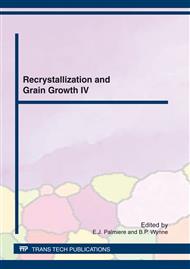p.813
p.819
p.825
p.831
p.837
p.843
p.849
p.853
p.854
Goss Texture Formation by Strain Induced Boundary Migration in Semi-Processed Nonoriented Electrical Steels
Abstract:
Semi-processed nonoriented electrical steels are very attractive products whose magnetic properties are significantly improved through annealing treatment in customers plant. The improvement is due to strong Goss texture formation by strain induced boundary migration (SIBM). In order to the effect of temper rolling reduction on the strengthening of Goss texture, temper rolling reduction was changed in the range of 2% to 8%. The annealing times was changed from 10 minutes to 180 minutes. A mechanism of grain growth during SIBM is suggested from our experimental data. In the specimen temper-rolled by 2%, relatively strong {111}<112> texture develops, whereas in the specimens temper-rolled by 4% through 8%, strong Goss texture develops as a result of SIBM during final annealing. It can be found from observed EBSD data that the Goss grains have the lowest stored energy in all temper-rolled specimens, which is confirmed by average image quality value in EBSD measurements. However, for the Goss grains to grow preferentially, stored energy difference between Goss grains and their neighboring grains may have to be higher than a certain critical value.
Info:
Periodical:
Pages:
837-842
Citation:
Online since:
April 2012
Authors:
Price:
Сopyright:
© 2012 Trans Tech Publications Ltd. All Rights Reserved
Share:
Citation:


